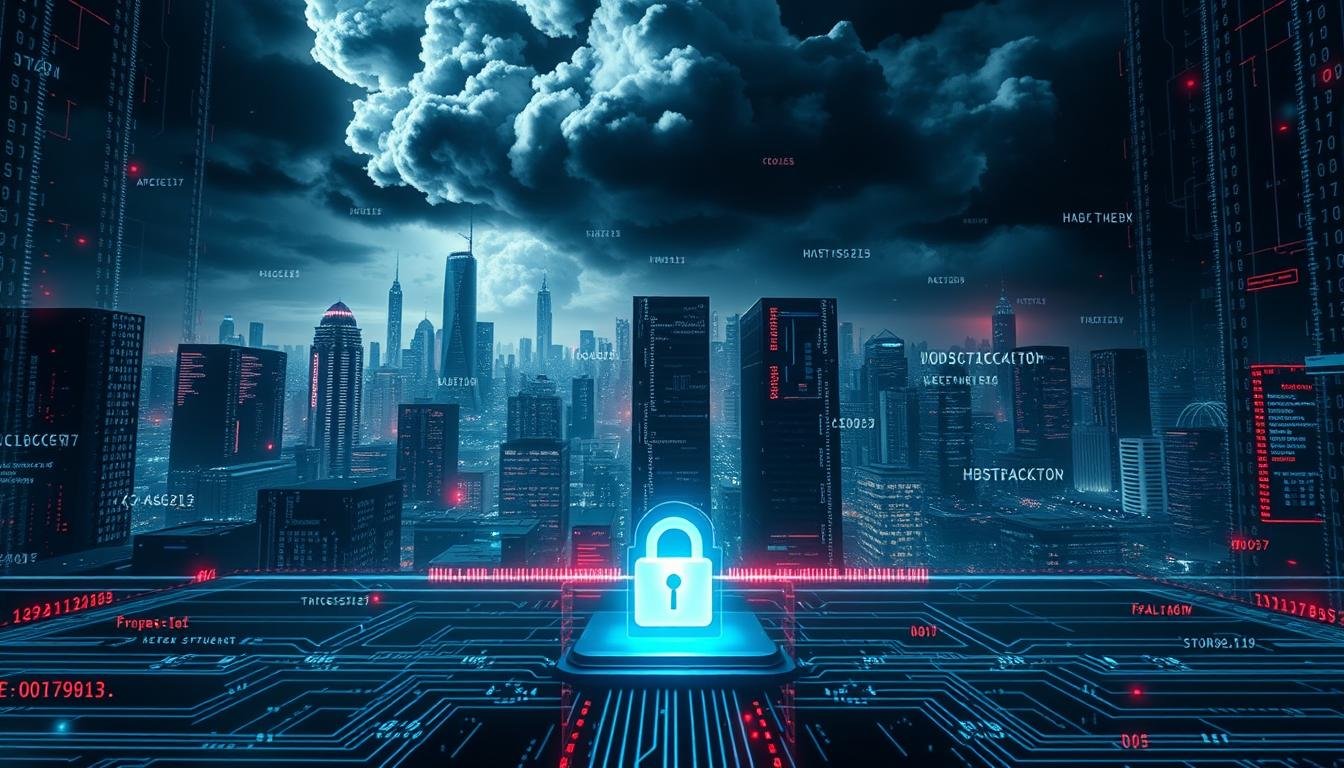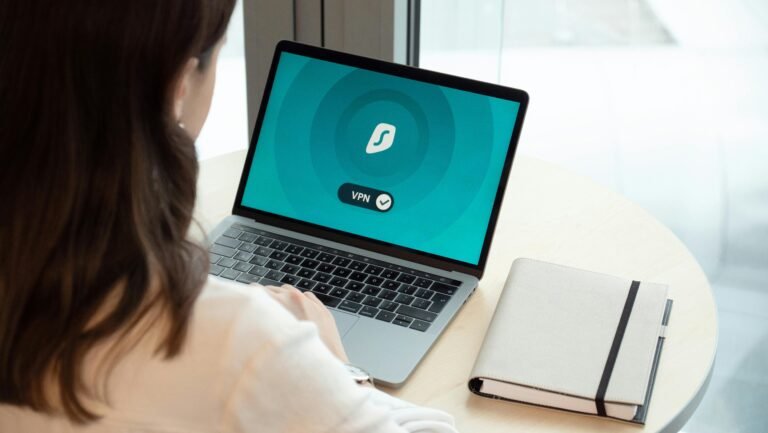Cybersecurity Threats and Solutions: Protect Yourself
Every 39 seconds, a cyberattack happens somewhere in the world. This makes keeping your online world safe very important. It’s key to know how to protect yourself from cyber threats and stop attacks before they start. Cybersecurity threats and solutions keep changing, so staying up-to-date is crucial.
To keep yourself safe, you must know about the latest cyber threats and solutions. This means understanding the dangers of public networks, using strong passwords, and the good of multi-factor authentication. By doing these things, you can lower the chance of your account being hacked and keep your online world safe.
Key Takeaways
- Every 39 seconds, a cyberattack occurs worldwide, highlighting the need for robust cybersecurity threats and solutions.
- Multi-factor authentication can prevent 80-90% of cyber-attacks, making it a crucial component of online security.
- Using strong passwords with a minimum of 12 characters, including uppercase and lowercase letters, numbers, and symbols, can enhance your online security.
- Regular transaction tracking and monitoring can help you detect suspicious activity and prevent cyber attacks.
- Staying informed about the latest cybersecurity threats and solutions is essential to protect yourself and your online security.
- Freezing credit with major bureaus and using chip-enabled credit cards can provide additional layers of security and protect you from fraud.
- Responding to security questions with unrelated answers can provide extra security, making it harder for cybercriminals to guess your credentials.
Understanding Modern Cybersecurity Threats
When you’re online, you face many cybersecurity threats. These can harm your personal info and money. Cyber attacks are getting smarter, so knowing the threats is key.
There are many types of cyber attacks. Phishing, malware, and ransomware are common. These can lead to big problems like identity theft and financial loss.
Phishing attacks are a big problem, causing 90% of data breaches. In 2023, a data breach cost about $4.45 million. Knowing about these threats helps keep you safe.
Common Types of Cyber Attacks
- Phishing attacks: 90% of data breaches
- Malware: 94% of all cyber threats
- Ransomware: 70% of organizations report experiencing a ransomware attack
To protect yourself, be careful with links and emails. Use strong passwords and keep your software updated. Cyber threats change often, so stay alert and protect yourself.
The Rising Tide of Data Breaches
Data breaches are getting more common. It’s key to know what happens when they happen. The cost of a data breach in 2023 was $4.24 million. This shows how much money businesses lose.
These breaches can lead to identity theft, losing money, and losing personal data.
Some important stats to remember are:
- The average time to find and fix data breaches is about 280 days.
- 60% of small businesses might close in six months after a breach.
- Ransomware attacks happen every 11 seconds. They are expected to cause $20 billion in damage by the end of 2023.
To stay safe from cybersecurity threats and data breaches, take action. Use strong passwords, turn on two-factor authentication, and check your credit reports. Knowing the risks and acting can help avoid being a victim of a data breach.

Spending on cybersecurity awareness programs is smart. It lowers the chance of cyber attacks more than the cost of fixing a breach. Training employees regularly helps spot threats fast. This makes responding to incidents quicker.
| Year | Average Cost of a Data Breach |
|---|---|
| 2022 | $4.35 million |
| 2023 | $4.24 million |
Essential Digital Security Foundations
To keep yourself safe online, you need strong digital security. This means using password management tips and two-factor authentication. These steps help keep your accounts safe from hackers.
Password management is very important. It’s about making strong, different passwords for each site. A password manager can help you keep these passwords safe. Also, two-factor authentication adds extra security to your accounts.
Here are some digital security tips:
- Make strong, different passwords for each site.
- Use two-factor authentication when you can.
- Keep your software up to date to avoid bugs.
By following these tips, you can lower the risk of online threats. A strong digital security base helps protect your online identity. Always remember, a solid foundation is crucial for digital security and keeping your personal info safe.
| Security Measure | Effectiveness |
|---|---|
| Password Management | 40% reduction in unauthorized access incidents |
| Two-Factor Authentication | Up to 99.9% reduction in account compromise risk |
Social Engineering: The Human Element of Cyber Attacks
Social engineering tricks people into sharing secrets or doing things they shouldn’t. It uses psychology, not tech, to attack. To stay safe, watch out for weird emails, calls, or messages online.
The 2013 Target breach hurt over 110 million people. The 2013 and 2014 Yahoo breaches hit 3 billion accounts. These show why we must be careful and protect ourselves.
To fight social engineering, know the different attacks. Here are a few:
- Phishing: emails or messages that trick you into revealing sensitive information
- Pretexting: attackers invent stories to gain trust
- Baiting: attackers offering enticing promises to victims

Knowing these attacks helps you stay safe. Social engineering is a big threat. Always be careful and watchful online.
Cybersecurity Threats and Solutions: Protect Yourself in Today’s Digital Age
To keep your data safe, use encryption and secure ways to talk online. This helps protect your personal info. It also lowers the chance of data theft and cyber attacks.
Recent data shows 65% of organizations faced cyberattacks in 2022. To fight this, use extra steps to log in, pick hard passwords, and lock your credit. These steps help keep you safe from online dangers.
- Use strong and unique passwords for all accounts
- Enable two-factor authentication whenever possible
- Keep your software and operating system up to date
- Use a reputable antivirus program
- Be cautious when clicking on links or downloading attachments from unknown sources
By using these tips, you can lower the risk of online threats. Remember, keeping your data safe is everyone’s job. By being careful, you help stop cyber attacks and stay safe online.
| Cybersecurity Threats | Personal Data Protection Strategies |
|---|---|
| Data breaches | Use encryption and secure communication protocols |
| Cyber attacks | Use multi-factor authentication and strong passwords |
| Phishing attacks | Be cautious when clicking on links or downloading attachments |
Advanced Security Measures for Complete Protection
To keep your digital world safe, you need advanced security measures. These help keep you safe from many cyber dangers. Always be careful with links, attachments, and software from places you don’t know.
Here are some ways to make your security better:
- Use secure internet ways
- Put in strong security steps, like stopping bad traffic
- Check for weak spots often
By doing these things, you can lower the chance of cyber attacks. And you’ll keep your important info safe. Remember, complete protection means using advanced security measures and staying alert all the time.
Building Your Cyber Defense Strategy
To keep your data safe, you need a good cyber defence plan. This plan should include using security software like antivirus and anti-malware. It’s also important to do regular security checks to find and fix weak spots.
Having a plan for when a cyber-attack happens is key. This plan helps you act fast and lessen the harm. Updating software regularly and using auto updates can stop many problems.
Some good security tools are:
- Antivirus programs
- Anti-malware programs
- Firewall software
Using these tools and keeping your software up to date can really help protect you. This way, you can stay safe from cyber threats.
Having a strong cyber defence plan is very important. It helps keep your data safe. By using security software, doing regular checks, and having a plan for attacks, you can lower the risk of a breach.
| Security Measure | Effectiveness |
|---|---|
| Implementing security software solutions | High |
| Conducting regular security audits | High |
| Having an incident response plan in place | High |
Emerging Technologies in Cybersecurity Protection
As you explore the world of cybersecurity, it’s key to know about new emerging technologies. These can boost your cybersecurity protection. The European Union Agency for Cybersecurity (ENISA) warns of more supply chain attacks. This is because software is released faster, making strong security a must.
Advanced artificial intelligence will soon be used for deepfake attacks. This means nation-states and groups can trick people. To fight these dangers, companies need to teach their teams about security risks. They should also watch out for weaknesses in third-party apps and software.
- Keep an eye on supply chains and digital spaces
- Use multi-factor authentication and least privilege access
- Do regular security checks and plan for incidents
By keeping up with emerging technologies and using these tips, you can improve your cybersecurity protection. This way, you can stay safe from future threats.
Conclusion: Empowering Your Digital Security Journey
As you finish this journey through cybersecurity threats and solutions, remember it’s ongoing. By using the strategies and best practices from this article, you can protect yourself. This helps you stay safe from new cyber threats.
It’s important to stay alert and keep your security up to date. Use the resources given to learn more about cybersecurity. Also, look into new tech that can help protect you.
To keep your digital security journey strong, be proactive and care about your online safety. Check your privacy settings often. Use strong passwords and two-factor authentication to keep your info safe. Simple steps can make a big difference in your security.
Use this knowledge to feel safe online. Your digital security is key to enjoying the modern world. Start this journey with caution, strength, and a strong will to keep your digital life safe.








